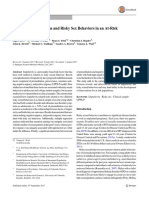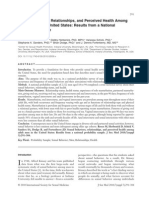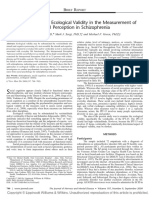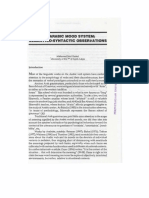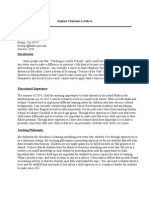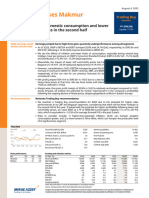Causes of Child and Youth Homeless in Developed and Developing Countries A Systematic Review - Part3
Causes of Child and Youth Homeless in Developed and Developing Countries A Systematic Review - Part3
Uploaded by
marufa0915Copyright:
Available Formats
Causes of Child and Youth Homeless in Developed and Developing Countries A Systematic Review - Part3
Causes of Child and Youth Homeless in Developed and Developing Countries A Systematic Review - Part3
Uploaded by
marufa0915Original Title
Copyright
Available Formats
Share this document
Did you find this document useful?
Is this content inappropriate?
Copyright:
Available Formats
Causes of Child and Youth Homeless in Developed and Developing Countries A Systematic Review - Part3
Causes of Child and Youth Homeless in Developed and Developing Countries A Systematic Review - Part3
Uploaded by
marufa0915Copyright:
Available Formats
Causes of Child and Youth Homelessness Original Investigation Research
development countries.13 We defined developing countries as sons for street involvement. When more than 1 study
all those in the high, medium, and low development catego- reported on the same sample population,16-24 the source
ries and developed countries as those in the top quartile and containing the most detailed data about the reasons for
classified as very high in the United Nations Development Pro- street involvement was selected for the review.17,19,21,24 Data
gramme 2013 Human Development Index Report.13 extraction was performed independently by L.E. and J.G.,
and then the results were compared. Any disagreements
Search Strategy and Study Selection were discussed until a consensus was reached. When it was
We searched for any published peer-reviewed study from 1990 not possible to extract the data from the publication, we
through July 2013 that reported quantitative reasons for street contacted the authors to ask for clarification.
involvement. Studies were included if they met the following
inclusion criteria: (1) participants were 24 years of age or Reasons and Variables
younger, (2) participants met our definition of street- Extracted data on reasons were sorted and compiled into cat-
connected children and youth, and (3) quantitative reasons for egories. The review team agreed on 6 categories that best rep-
street involvement were reported. We included the following resented the themes that emerged: poverty, abuse, family con-
study designs: cross-sectional, cohort, case-control, mixed- flict, delinquency, psychosocial health, and other reasons.
methods, qualitative studies reporting quantitative reasons, When studies reported multiple reasons per category, we used
and interventions that provided baseline data on reasons for the most frequent response in the meta-analysis. Poverty con-
street involvement. We excluded publications that were not sisted of the following variables: poverty, hunger, work to get
written in English or that were dissertations, books, and con- money, housing instability, rural to urban migration, struc-
ference abstracts. tural, and refugee/conflict/war displacement. Abuse con-
Electronic searches of Scopus, PsychINFO, EMBASE, sisted of the following variables as reported in the studies:
POPLINE, PubMed, ERIC, and the Social Sciences Citation In- physical abuse, sexual abuse, and abuse/maltreatment and ne-
dex were conducted from January 1, 1990, to the third week glect. Family conflict consisted of the following variables: fam-
of July 2013. The following broad search strategy was used to ily conflict, escape home problems, abandoned, family is-
search the databases: “street children” OR “street youth” OR sues, domestic violence, orphaned, substance use at home,
“homeless youth” OR “homeless children” OR “runaway chil- alcoholism at home, thrown out, mutual decision with par-
dren” OR “runaway youth” or “homeless persons.” ents, and brought to the streets by family/relative. Delin-
After duplicates were removed, 2 independent reviewers quency consisted of the following variables: delinquency, con-
(L.E. and J.G.) screened the titles and abstracts and excluded flict with the law, and removed by authorities. Psychosocial
all records that did not meet the inclusion criteria. If either of health consisted of the following variables: sexuality/gender
the reviewers found an article to be relevant, a full-text copy issues, mental health, anxiety/depression, conflict with friends,
of the article was obtained, and its eligibility assessed inde- traumatic events, personal drug and alcohol use, pregnancy,
pendently. Disagreements were resolved by discussion be- and peer pressure. Other reasons consisted of the following vari-
tween the 2 reviewers, and a third reviewer assisted when con- ables: runaway, desire to go to the city, independence, no clear
sensus could not be reached. A final list of studies to be included reason, and other.
in this systematic review was agreed on, and the data were ex-
tracted. The authors included data from their own unpub- Analysis
lished work that was under review at the time of their search.14 We considered a binary response (yes/no) for each reason for
Reference lists of selected articles were scanned to identify ad- street involvement to estimate pooled prevalence and to
ditional relevant documents. assess effect of covariates, while accounting for individual
study variations by introducing random intercepts. First, we
Study Quality fit logistic mixed-effects models to estimate the pooled
The assessment of methodological quality was used to deter- prevalence (ie, pooled mean proportion) of each reason, and
mine whether the studies adequately reported study compo- to estimate subgroup pooled prevalence by development
nents essential to any study design. A critical appraisal tool was level or geographic region. Separate models were fit for each
adapted to assess 10 items that should be reported to effec- reason using only studies that examined the reason as a
tively assess the validity of a study’s findings.15 Details of the source of street involvement. To evaluate sex difference, we
study quality assessment tool and the results of assessing study first created the number of female and male youth who
quality are available in the eAppendix and eTable 1 in the reported yes/no to each reason from a study, and reshaped
Supplement. The quality assessment was performed indepen- the data into a long format where each sex-yes/no datum is
dently by L.E. and J.G. Afterward, the 2 sets of results were com- in a separate observation. For example, individual study
pared, and any disagreements were discussed until a consen- data were separated into 4 observations with a variable (say,
sus was reached. num) representing number of male-poverty yes, male-
poverty no, female-poverty yes, and female-poverty no.
Data Extraction Interactions between sex and the other covariates, such as
Data were extracted by 2 independent reviewers (L.E. and development level or geographic region, were generated to
J.G.) and included details about the study’s design, setting, estimate the subgroup pooled prevalence of each reason and
population demographics, and results for all reported rea- to assess sex difference within a specific covariate level (eg,
jamapediatrics.com (Reprinted) JAMA Pediatrics Published online April 4, 2016 E3
Copyright 2016 American Medical Association. All rights reserved.
Downloaded From: http://archpedi.jamanetwork.com/ by a Universite Laval User on 04/05/2016
You might also like
- Conformity Literature ReviewDocument5 pagesConformity Literature ReviewAnonymous vQbjir25YNo ratings yet
- Nosek Et Al 2007 Pervasiveness and Correlates of Implicit Attitudes and StereotypesDocument53 pagesNosek Et Al 2007 Pervasiveness and Correlates of Implicit Attitudes and StereotypeshoorieNo ratings yet
- Differential Item Functioning on Antisocial Behavior ScaleDocument12 pagesDifferential Item Functioning on Antisocial Behavior ScaleAli Al-SubaihiNo ratings yet
- Bullying InternasionalDocument19 pagesBullying InternasionalNarisaNo ratings yet
- Behavioral and Emotional Problems Reported by Parents of Children Ages 6 To 16 in 31 SocietiesDocument15 pagesBehavioral and Emotional Problems Reported by Parents of Children Ages 6 To 16 in 31 SocietiesBá MoreiraNo ratings yet
- BF00985658Document18 pagesBF00985658inessilvapereira249No ratings yet
- Gross Hardin 2007-ReadDocument21 pagesGross Hardin 2007-ReadMadalyn De JesusNo ratings yet
- Goldfarb2020 PDFDocument15 pagesGoldfarb2020 PDFJulia Mar Antonete Tamayo AcedoNo ratings yet
- 1975 - The Behavioral Assessmentof Male and Female Social Competence in Dyadic Heterosexual InteractionsDocument11 pages1975 - The Behavioral Assessmentof Male and Female Social Competence in Dyadic Heterosexual InteractionsGabriel CandidoNo ratings yet
- Piskur - 1992 - Attitude and OrientationDocument7 pagesPiskur - 1992 - Attitude and Orientationlevi nilawatiNo ratings yet
- Wright1999 Article DevelopmentAndValidationOfTheHDocument11 pagesWright1999 Article DevelopmentAndValidationOfTheHΚωνσταντίνος ΚόντηςNo ratings yet
- Sexual Dysfunction in The United States: Prevalence and PredictorsDocument9 pagesSexual Dysfunction in The United States: Prevalence and Predictorscepavek196No ratings yet
- A Longitudinal Behavioral Genetic Analysis of The Etiology of Aggressive and Nonaggressive Antisocial BehaviorDocument21 pagesA Longitudinal Behavioral Genetic Analysis of The Etiology of Aggressive and Nonaggressive Antisocial BehaviorNido FariasNo ratings yet
- Cognitive Psychology Paper 1Document6 pagesCognitive Psychology Paper 1Aditi VasavaNo ratings yet
- An Empirical Study On Homophobia Among Post Graduate Students in KolkataDocument4 pagesAn Empirical Study On Homophobia Among Post Graduate Students in KolkataIJAR JOURNALNo ratings yet
- Khurana 2019Document12 pagesKhurana 2019Xaje PoNo ratings yet
- Dewall Maner 2008 High Status Men (But Not Women) Capture The Eye of The BeholderDocument14 pagesDewall Maner 2008 High Status Men (But Not Women) Capture The Eye of The Beholderagustin.spezinibNo ratings yet
- International Journal of Developmental Science, 5,103-111. DoiDocument26 pagesInternational Journal of Developmental Science, 5,103-111. DoiКовачевић ЈасминаNo ratings yet
- PSYC6213 Final Paper NotesDocument14 pagesPSYC6213 Final Paper NotesMiryam MNo ratings yet
- Campbell Systematic Reviews - 2021 - Littell - Multisystemic Therapy For Social Emotional and Behavioural Problems inDocument192 pagesCampbell Systematic Reviews - 2021 - Littell - Multisystemic Therapy For Social Emotional and Behavioural Problems inlidiaprieto.psicologiaNo ratings yet
- Article20220word20form20final20 (1) 2Document9 pagesArticle20220word20form20final20 (1) 2Tanuja KapriNo ratings yet
- Kim 2022 Evaluating The Use of Self-Reported Measures in Autistic Individuals in The Context of Psychiatric Assessment A Systematic ReviewDocument21 pagesKim 2022 Evaluating The Use of Self-Reported Measures in Autistic Individuals in The Context of Psychiatric Assessment A Systematic ReviewDayna DamianiNo ratings yet
- SazeciDocument4 pagesSazeciPetra AnicNo ratings yet
- Beaver and Wright 2011 School Level Genetic Variation Predicts School Level Verbal Iq Scores ResultsDocument5 pagesBeaver and Wright 2011 School Level Genetic Variation Predicts School Level Verbal Iq Scores Resultshurrhurrdurr3No ratings yet
- Investigating The Validity of The Wong and Law Emotional Intelligence Scale in A Nepali Student SampleDocument25 pagesInvestigating The Validity of The Wong and Law Emotional Intelligence Scale in A Nepali Student Samplekoffi aya michèleNo ratings yet
- Callous-Unemotional Traits and Their Implication For Understanding and Treating Aggressive and Violent YouthsDocument20 pagesCallous-Unemotional Traits and Their Implication For Understanding and Treating Aggressive and Violent YouthsMaría Teresa Carrasco OjedaNo ratings yet
- s10508-008-9388-z (1)Document13 pagess10508-008-9388-z (1)Götz-Kocsis ZsuzsannaNo ratings yet
- APSR Candidate Genes and Political Behavior-1Document34 pagesAPSR Candidate Genes and Political Behavior-1Alessandro FreireNo ratings yet
- Applied Statistics in Business & Economics ReviewDocument7 pagesApplied Statistics in Business & Economics ReviewJennNo ratings yet
- Stone 1987Document16 pagesStone 1987Στέργιος ΚNo ratings yet
- Altruism and Aggression 1986Document7 pagesAltruism and Aggression 1986MegaaNeesh NeshNo ratings yet
- 1-s2.0-S0022096521000989-mainDocument18 pages1-s2.0-S0022096521000989-mainsaragad301999No ratings yet
- Articol Delicventa JuvenilaDocument43 pagesArticol Delicventa JuvenilaBianca TekinNo ratings yet
- Julio Cesar Augarde Rydon-Grange 2021Document17 pagesJulio Cesar Augarde Rydon-Grange 2021Gustavo Silva BarbosaNo ratings yet
- Alexander Et Al. Risky Sexual BehaviorDocument7 pagesAlexander Et Al. Risky Sexual Behaviortwumasisandra8No ratings yet
- Adolescent Personality Disorders Associated With Violence and Criminal Behavior During Adolescence and Early AdulthoodDocument7 pagesAdolescent Personality Disorders Associated With Violence and Criminal Behavior During Adolescence and Early AdulthoodIoana Duminicel100% (1)
- Curry2017 UppsDocument8 pagesCurry2017 UppsXaje PoNo ratings yet
- Schoolarly Article About Peanuts Allergy Correlated With Squirrele ToleranceDocument11 pagesSchoolarly Article About Peanuts Allergy Correlated With Squirrele ToleranceMark SmithNo ratings yet
- Peer Selection and Socialization Effects On Adolescent Intercourse Without A Condom and Attitudes About The Costs of SexDocument14 pagesPeer Selection and Socialization Effects On Adolescent Intercourse Without A Condom and Attitudes About The Costs of SexTwradioNo ratings yet
- hook2008Document8 pageshook2008ali.monther94No ratings yet
- Kaplan et al. (2013)Document7 pagesKaplan et al. (2013)hhdgzp9cj2No ratings yet
- Diagnosis and Classification Autism DSMDocument29 pagesDiagnosis and Classification Autism DSMMaximiliano NoriaNo ratings yet
- Original Research: Aims. MethodsDocument11 pagesOriginal Research: Aims. Methodsscribd_com3286No ratings yet
- Development and Validation of A Scale To Measure Intimate Partner Violence Among Transgender and Gender Diverse Populations Protocol For A Linear Three-Phase Study (Project Empower)Document12 pagesDevelopment and Validation of A Scale To Measure Intimate Partner Violence Among Transgender and Gender Diverse Populations Protocol For A Linear Three-Phase Study (Project Empower)Aaron SNo ratings yet
- Sexual Behaviors, Relationships, and Perceived Health Among Adult Men in The United States: Results From A National Probability SampleDocument14 pagesSexual Behaviors, Relationships, and Perceived Health Among Adult Men in The United States: Results From A National Probability Samplescribd_com3286No ratings yet
- NIH Public AccessDocument19 pagesNIH Public AccessTeodora RusuNo ratings yet
- Changes in Penile-Vaginal Intercourse Frequency and Sexual Repertoire From 2009 To 2018 Findings From The National Survey of Sexual Health and BehaviorDocument15 pagesChanges in Penile-Vaginal Intercourse Frequency and Sexual Repertoire From 2009 To 2018 Findings From The National Survey of Sexual Health and BehaviorAndres RivasNo ratings yet
- Veena Singh-048-091 - Review of Literature PDFDocument44 pagesVeena Singh-048-091 - Review of Literature PDFValerine SNo ratings yet
- Social Support Questionnaire - Shortened Version: ReferenceDocument3 pagesSocial Support Questionnaire - Shortened Version: ReferenceAnanya royNo ratings yet
- Child abuseDocument13 pagesChild abusepawan.abilitiesNo ratings yet
- Instructing Animosity 11.13.24Document24 pagesInstructing Animosity 11.13.24Susan DuclosNo ratings yet
- Personality Assessment in A Diverse Urban Sample: Brief ReportDocument6 pagesPersonality Assessment in A Diverse Urban Sample: Brief ReportNaga Sayana Srinivas KoneruNo ratings yet
- 0001 Questionnaire Wave1 MULTIDocument28 pages0001 Questionnaire Wave1 MULTIAmber DeyNo ratings yet
- Review: Cultural Aspects in Social Anxiety and Social Anxiety DisorderDocument12 pagesReview: Cultural Aspects in Social Anxiety and Social Anxiety DisorderNanda YonsonNo ratings yet
- The Impact of Anthony Greenwald Iat ResearchDocument9 pagesThe Impact of Anthony Greenwald Iat Researchapi-534201968No ratings yet
- Cross-Sectional and Longitudinal Epidemiological Studies of Internet Gaming Disorder: A Systematic Review of The LiteratureDocument20 pagesCross-Sectional and Longitudinal Epidemiological Studies of Internet Gaming Disorder: A Systematic Review of The LiteratureJason LiberiNo ratings yet
- Vaskin 2009Document3 pagesVaskin 2009RosarioBengocheaSecoNo ratings yet
- A Follow-Up Study of Girls With Gender Identity DisorderDocument12 pagesA Follow-Up Study of Girls With Gender Identity Disorderlurch404No ratings yet
- Transparent and Reproducible Social Science Research: How to Do Open ScienceFrom EverandTransparent and Reproducible Social Science Research: How to Do Open ScienceNo ratings yet
- Practitioner's Guide to Empirically Based Measures of Social SkillsFrom EverandPractitioner's Guide to Empirically Based Measures of Social SkillsNo ratings yet
- Pages From 437688790-DG7-1Document1 pagePages From 437688790-DG7-1marufa0915No ratings yet
- Causes of Child and Youth Homeless in Developed and Developing Countries A Systematic Review - Part9Document1 pageCauses of Child and Youth Homeless in Developed and Developing Countries A Systematic Review - Part9marufa0915No ratings yet
- Causes of Child and Youth Homeless in Developed and Developing Countries A Systematic Review - Part11Document1 pageCauses of Child and Youth Homeless in Developed and Developing Countries A Systematic Review - Part11marufa0915No ratings yet
- Causes of Child and Youth Homeless in Developed and Developing Countries A Systematic Review - Part10Document1 pageCauses of Child and Youth Homeless in Developed and Developing Countries A Systematic Review - Part10marufa0915No ratings yet
- Causes of Child and Youth Homeless in Developed and Developing Countries A Systematic Review - Part4Document1 pageCauses of Child and Youth Homeless in Developed and Developing Countries A Systematic Review - Part4marufa0915No ratings yet
- Prisma DemoDocument1 pagePrisma Demomarufa0915No ratings yet
- Journal - Pone.0247156 (1) - Part2Document2 pagesJournal - Pone.0247156 (1) - Part2marufa0915No ratings yet
- Journal - Pone.0247156 (1) - Part1Document2 pagesJournal - Pone.0247156 (1) - Part1marufa0915No ratings yet
- TSVETKOVDocument2 pagesTSVETKOVfaaaafNo ratings yet
- Step Up Math 7 Integer6Document1 pageStep Up Math 7 Integer6zfrl0% (1)
- Policy Implementation of Ra 9003 - Bulsu-ScDocument22 pagesPolicy Implementation of Ra 9003 - Bulsu-ScPerry Arcilla SerapioNo ratings yet
- Diarrhea Cmap ScriptDocument5 pagesDiarrhea Cmap ScriptmaryNo ratings yet
- l1 9-11 Dentin Hypersensitivity - DR VivekDocument28 pagesl1 9-11 Dentin Hypersensitivity - DR VivekJu JuNo ratings yet
- INOVOL F3600 Polyether Polyol TDSDocument1 pageINOVOL F3600 Polyether Polyol TDSvikashNo ratings yet
- Show Program - BDocument8 pagesShow Program - BRumble TheatreNo ratings yet
- ACC 576 Exam 1 NotesDocument1 pageACC 576 Exam 1 NotesWill HughesNo ratings yet
- AI-Driven Weapons Systems Lead Today's Arms RaceDocument8 pagesAI-Driven Weapons Systems Lead Today's Arms RaceAbdul HameedNo ratings yet
- Semantico Syntactic Observations: The Arabic Mood SystemDocument11 pagesSemantico Syntactic Observations: The Arabic Mood SystemArabic Tree learningNo ratings yet
- PH.D BA - Class Schedule 1-2018Document1 pagePH.D BA - Class Schedule 1-2018Adnan KamalNo ratings yet
- Ammonia Vapoeizer (E-3101b) - BkuDocument166 pagesAmmonia Vapoeizer (E-3101b) - BkuRAJESHWARNo ratings yet
- Jasmine Cheyanne LovelaceDocument2 pagesJasmine Cheyanne Lovelaceapi-266548379No ratings yet
- Mumbai Suburban Serial Blast CaseDocument11 pagesMumbai Suburban Serial Blast CaseunLAWk IndiaNo ratings yet
- DC80Document13 pagesDC80Rier AssistenciaNo ratings yet
- Artemis Accords: NASADocument18 pagesArtemis Accords: NASA10News WTSPNo ratings yet
- Msds Ethyl Oxide (Gas Eto)Document15 pagesMsds Ethyl Oxide (Gas Eto)ReniNo ratings yet
- Reclosers: Form 6 Microprocessor-Based Pole Mount Recloser Control Installation and Operation InstructionsDocument48 pagesReclosers: Form 6 Microprocessor-Based Pole Mount Recloser Control Installation and Operation InstructionsTrịnh Huy ĐảmNo ratings yet
- TT VDSL N32 PDFDocument6 pagesTT VDSL N32 PDFZelaya DudNo ratings yet
- Q1-2024 Initiative PlaningDocument10 pagesQ1-2024 Initiative PlaningnageswaraorayalaNo ratings yet
- 2009 UPLB Annual ReportDocument32 pages2009 UPLB Annual ReportUPLB Office of the Vice Chancellor for Research and ExtensionNo ratings yet
- Papers TarnavaDocument182 pagesPapers TarnavagusaNo ratings yet
- (已压缩)XCMG PeaCock Forklift (6 7t)Document6 pages(已压缩)XCMG PeaCock Forklift (6 7t)chenqiushuo99No ratings yet
- Automatic Ticket Assignment AIML Online Capstone Group 6Document21 pagesAutomatic Ticket Assignment AIML Online Capstone Group 6Richa AnandNo ratings yet
- Parts of SpeechDocument40 pagesParts of SpeechMounika ReddyNo ratings yet
- Practicum LPDocument8 pagesPracticum LPShah Rul MalikNo ratings yet
- Mirae Asset Sekuritas Indonesia INDF 2 Q23 Review A86140c7a2Document8 pagesMirae Asset Sekuritas Indonesia INDF 2 Q23 Review A86140c7a2Dhanny NuvriyantoNo ratings yet
- Oral Pathology 1Document1 pageOral Pathology 1Sai Vishnu PonnapalliNo ratings yet
- UnderwaterCities 1stexp Rules ENG WebDocument8 pagesUnderwaterCities 1stexp Rules ENG WebmooolkaNo ratings yet
- Music Dance - Teacher Researcher Portfolio by Rachel Hsieh - PJ 261Document13 pagesMusic Dance - Teacher Researcher Portfolio by Rachel Hsieh - PJ 261api-532470182No ratings yet




































